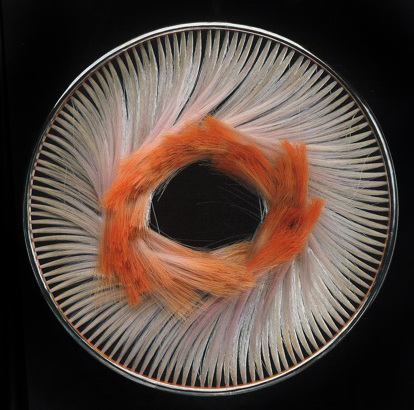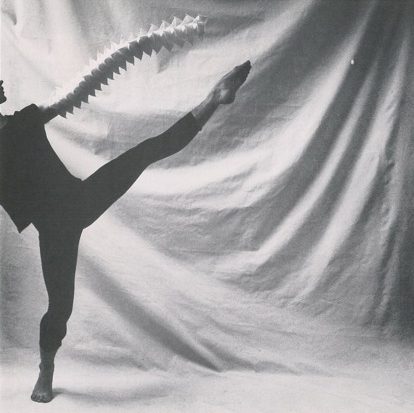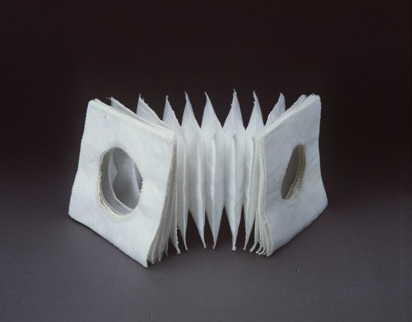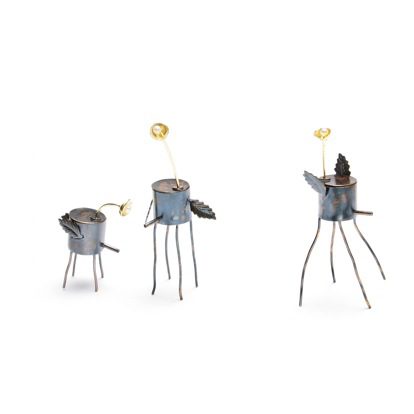Journal: Anna Davern
The work of Caroline Broadhead…

Neckpiece: silver, wood, dyed nylon monofilament (1978)
Image taken from the catalogue Inspired Jewellery From the Museum of Arts and Design, New York
I mentioned last week a conversation I had with Katherine Bowman about the British artist Caroline Broadhead. I was surprised to learn that Katherine knew little about the work of Caroline Broadhead and her British contemporaries from the 1970s and ‘80s. While the Dutch and German jewellers from this period have very strong profiles, it seems the British and American artists receive much less exposure.
I had seen Broadhead’s work in the New Jewellery book but it was while I was waiting for my interview to get in to Jewellery and Object Design at Sydney College of the Arts that I was nervously flicking through a catalogue(1) and came across these two images of work by Broadhead:

22 in 1 (armpiece): white cotton (1984)

18 Cushions (armpiece): folded white cotton (1984)
I was blown away by the way these works complemented and extended the body. And I realised that jewellery can be about the whole body and not just the finger, the ear, or (heaven forbid) the lapel!
This is what they look like when they’re not on the body:

22 in 1 (armpiece): white cotton (1984)
(Image: Powerhouse Museum Collection database)

18 Cushions (armpiece): folded white cotton (1984)
(Image: Powerhouse Museum Collection database)
“The form of each piece changes when it is worn or not worn and it is intended to be seen in both states. The form, proportions and the method of putting on and taking off the piece are all defined by the body.“
– Caroline Broadhead, quoted in the Cross Currents catalogue
While I am now more interested in exploring the role of jewellery and its relationship to identity, when I was a student I was very interested in how jewellery can foster an awareness of the relationship between the object and the body. Indeed, the title and abstract of my masters thesis is:
The jewellery object and intimacy: an examination of the relationship between the viewer and the object
The aim of this project is to examine the physical and psychological relationship between the viewer and the jewellery object. I will examine the format of the miniature to investigate how scale plays a role in our psychological attachment to objects. I will draw on my own memories of childhood to study the intense nature of the child’s relationship with objects. I will use jewellery’s inherent tactility to look at our physical relationship to objects and I will work with groups of objects to examine how our relationship with an individual jewellery object changes when it functions as part of a group.

Mozzie Tanks (objects with removable lids and earrings): brass, 18ct yellow gold, pearls (2005)
Elements of this are still evident when my work incorporates movement or invites interaction.

Collins Street Crusader (diorama with removable brooch): reworked biscuit tin, sublimate printed aluminium, copper (2008)

Kracken: re-worked biscuit tin, sublimate printed steel, constructed weighted cog mechanism (2010) (250 x 200 x 60 mm) (Image: Andrew Barcham)
Turn the crank to interact with the diorama
Fortunately I was accepted into the program at Sydney College of the Arts, which could’ve had something to do with mentioning my newfound admiration for Caroline Broadhead during the interview! I really value the education I received at SCA and next week’s post will be about the work of Margaret West who was the Head of Department during my undergraduate years there.
(1) Cross Currents: Jewellery from Australia Britain Germany Holland published by the Powerhouse Museum Sydney, 1984


